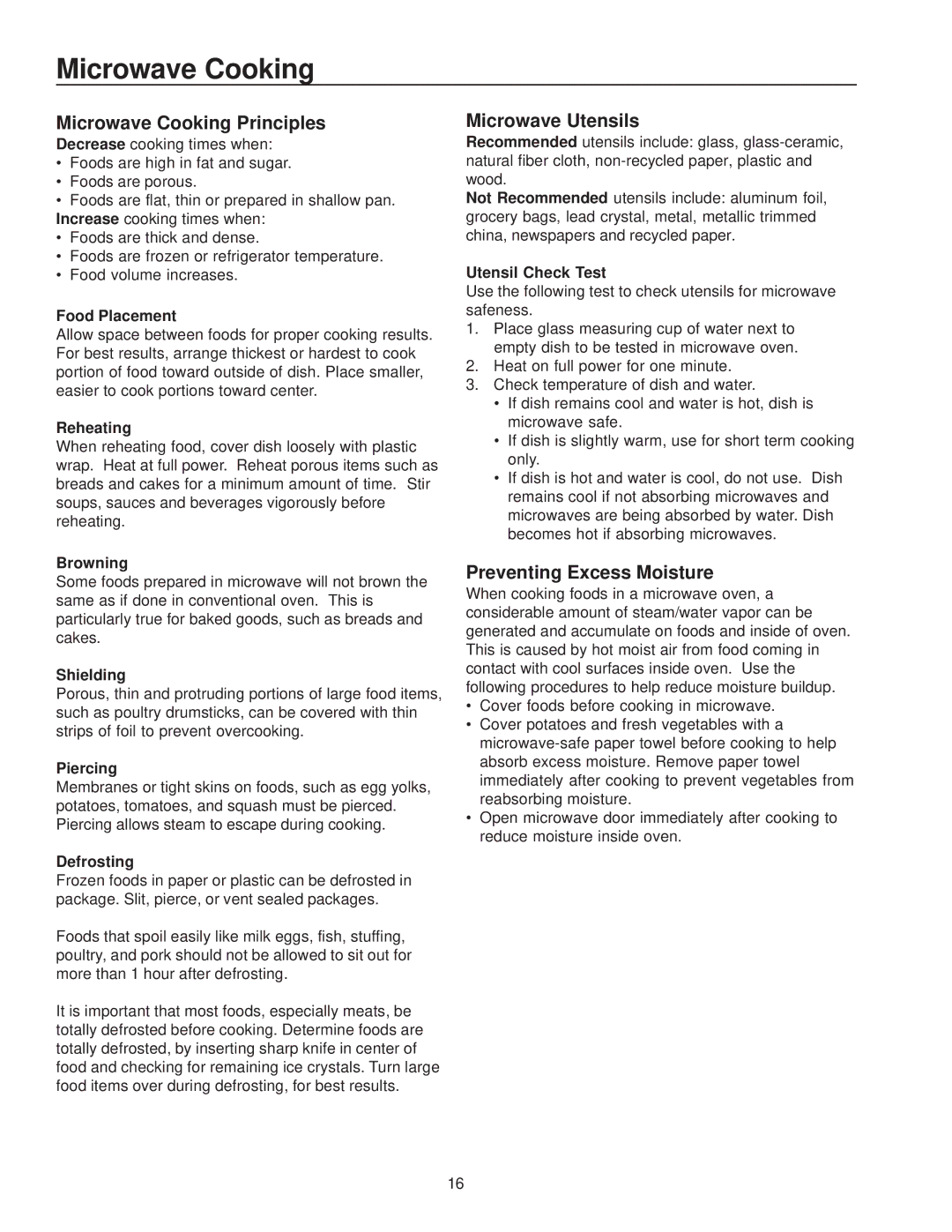Microwave Cooking
Microwave Cooking Principles
Decrease cooking times when:
•Foods are high in fat and sugar.
•Foods are porous.
•Foods are flat, thin or prepared in shallow pan. Increase cooking times when:
•Foods are thick and dense.
•Foods are frozen or refrigerator temperature.
•Food volume increases.
Food Placement
Allow space between foods for proper cooking results. For best results, arrange thickest or hardest to cook portion of food toward outside of dish. Place smaller, easier to cook portions toward center.
Reheating
When reheating food, cover dish loosely with plastic wrap. Heat at full power. Reheat porous items such as breads and cakes for a minimum amount of time. Stir soups, sauces and beverages vigorously before reheating.
Browning
Some foods prepared in microwave will not brown the same as if done in conventional oven. This is particularly true for baked goods, such as breads and cakes.
Shielding
Porous, thin and protruding portions of large food items, such as poultry drumsticks, can be covered with thin strips of foil to prevent overcooking.
Piercing
Membranes or tight skins on foods, such as egg yolks, potatoes, tomatoes, and squash must be pierced. Piercing allows steam to escape during cooking.
Defrosting
Frozen foods in paper or plastic can be defrosted in package. Slit, pierce, or vent sealed packages.
Foods that spoil easily like milk eggs, fish, stuffing, poultry, and pork should not be allowed to sit out for more than 1 hour after defrosting.
It is important that most foods, especially meats, be totally defrosted before cooking. Determine foods are totally defrosted, by inserting sharp knife in center of food and checking for remaining ice crystals. Turn large food items over during defrosting, for best results.
Microwave Utensils
Recommended utensils include: glass,
Not Recommended utensils include: aluminum foil, grocery bags, lead crystal, metal, metallic trimmed china, newspapers and recycled paper.
Utensil Check Test
Use the following test to check utensils for microwave safeness.
1.Place glass measuring cup of water next to empty dish to be tested in microwave oven.
2.Heat on full power for one minute.
3.Check temperature of dish and water.
•If dish remains cool and water is hot, dish is microwave safe.
•If dish is slightly warm, use for short term cooking only.
•If dish is hot and water is cool, do not use. Dish remains cool if not absorbing microwaves and microwaves are being absorbed by water. Dish becomes hot if absorbing microwaves.
Preventing Excess Moisture
When cooking foods in a microwave oven, a considerable amount of steam/water vapor can be generated and accumulate on foods and inside of oven. This is caused by hot moist air from food coming in contact with cool surfaces inside oven. Use the following procedures to help reduce moisture buildup.
•Cover foods before cooking in microwave.
•Cover potatoes and fresh vegetables with a
•Open microwave door immediately after cooking to reduce moisture inside oven.
16
